[ page 1 ]
Korean Aircraft Industries T-50 in 1/72 scale: kit review & modelling report of Academy kit
page 2
The T-50 is a supersonic advanced jet trainers and light combat aircraft. It was developed by Korea Aerospace Industries (KAI) with General Dynamics with studies starting in 1992 as KTX-2 to replace T-38 Talons and Hawks. The design became the T-50 and was named "Golden Eagle".
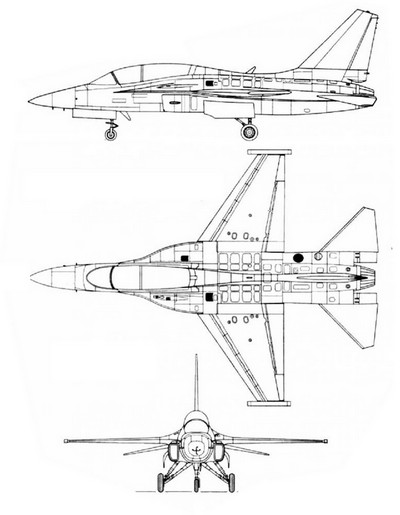
KAI also produced the F-16 in license so experience with this jet was used in the development which began in the late 1990s. Lockheed Martin acquired General Dynamics and continued with KAI the program with a full scale KTX-2 contract signed Oktober 1997. The type got a US made GE F404 jet engine and a two man cockpit. First flight was made August 2002.
The Republic of Korea Air Force Air Force (ROKAF) introduced the type in 2005. The South Korean air force's aerobatics team Black Eagles flies the T-50B type. Several variants were developed as trainer T and "fighter attack FA". A 20mm M61 gun is also an option with a gun nozzle in the left LERX. Other capabilities are Sidewinder missiles (also on wing tip rails), Mavericks, ECM, JDAM and various bombs.
The type was ordered by South Korea (>140 aircraft operated), Indonesia as T-50i, Philippines FA-50PH, Thailand T-50TH. Also "freed" Iraq T-50IQ ordered the type that were delivered from end 2019. It is reported that Colombia ordered TA-50 and FA-50 jets in April 2022. Poland and Malaysia ordered the type as well.
For the USAF T-X program for a new trainer a variant was proposed as the KT-X with new systems, a dorsal fairing and refuelling receptable. The USAF competition was lost however in 2018.
DATA: Length: 13,14 m; span with missiles: 9,45 m. Max speed 1,800 km/hr, Range 1800 km, Max TO weight 12,300 kg.
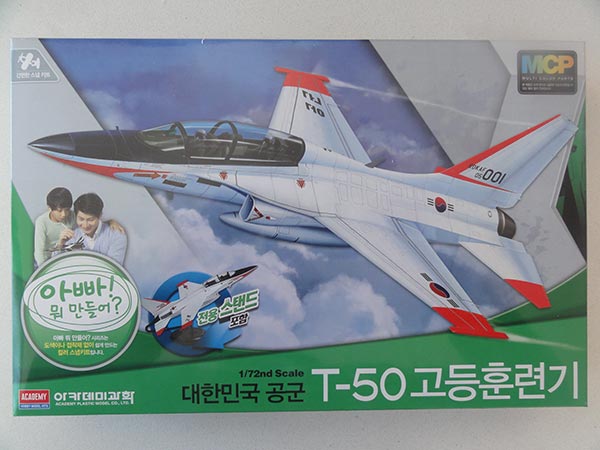
Academy from Korea released in 2015 a snap together 1/72 kit of the KAI T-50 Golden Eagle but it is for the prototype lay out. Kit #12519A from 2015 has only about 25 parts and "does not need glue" to assemble. It has plastic "multi colour parts" parts in white and black colour.
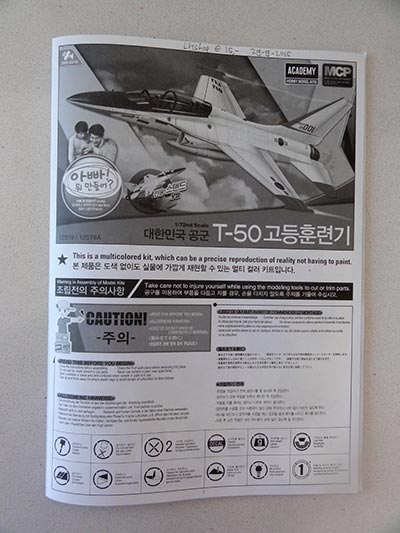
The instructions with 5 steps are fine but no brief history of the jet is included.
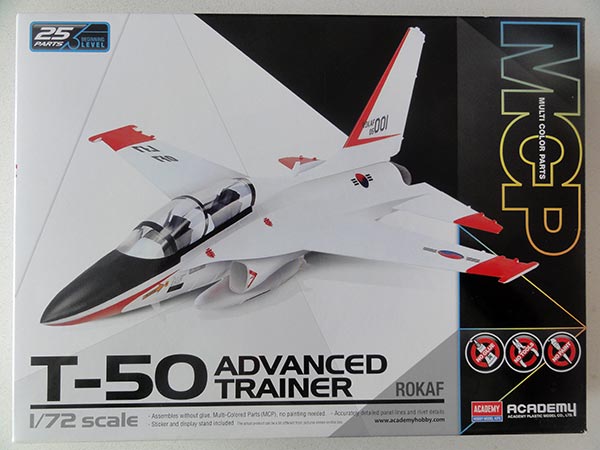
I also purchased kit release #12519 which is similar but has a black display stand and full colour instructions on glossy paper.
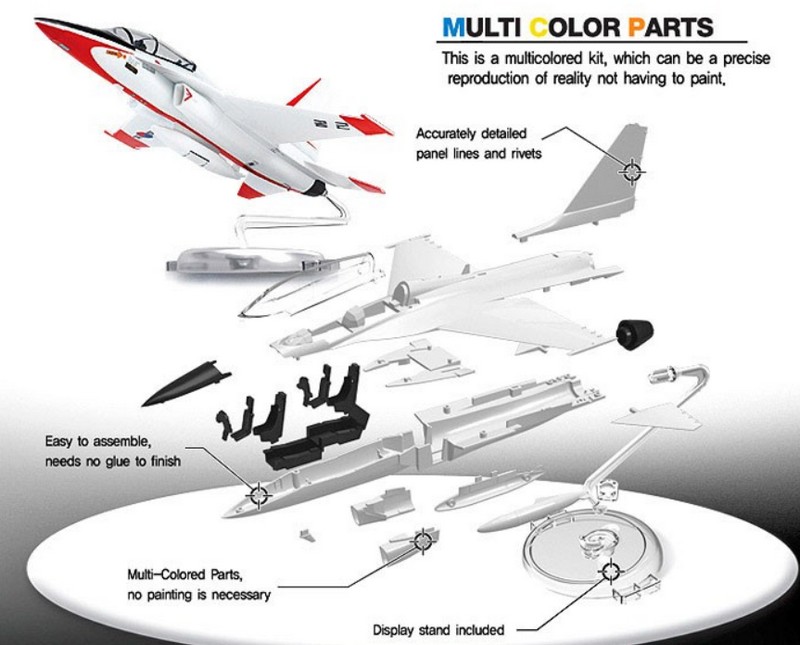
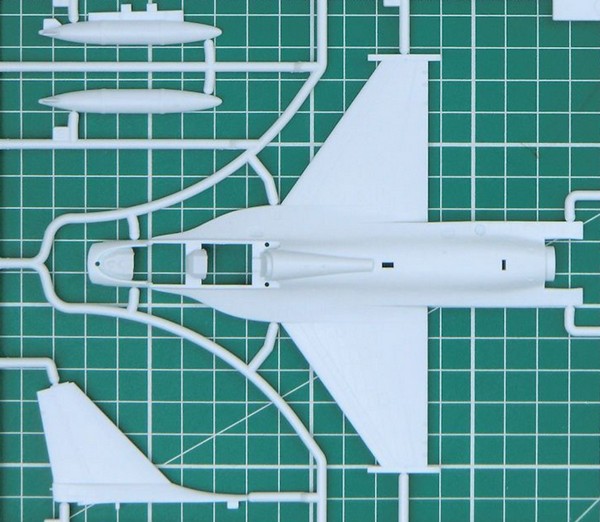
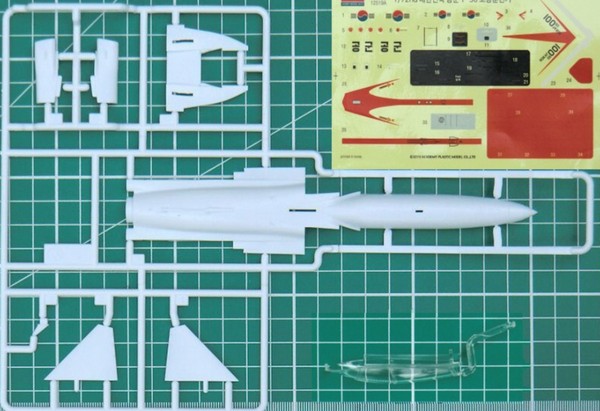
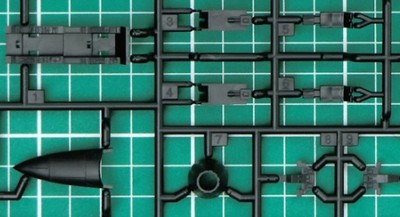
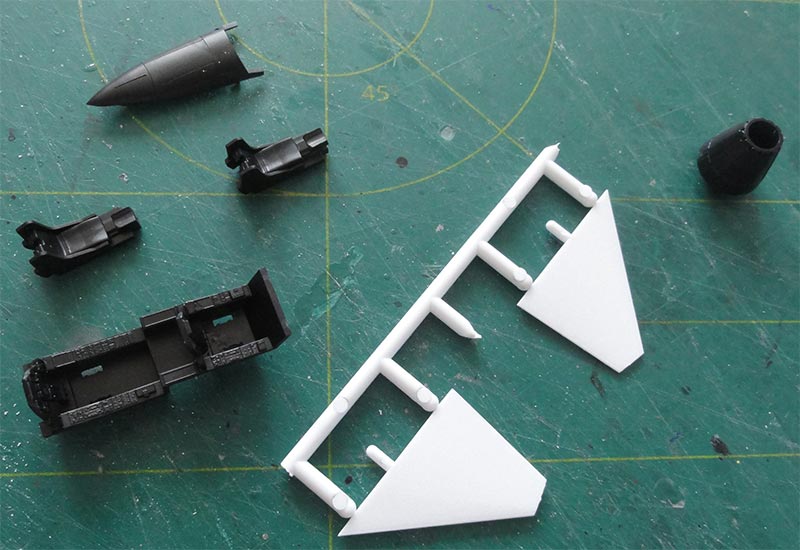
There are no waterslide decals but thick stick-on stickers for single scheme R.O.K scheme in white and red.
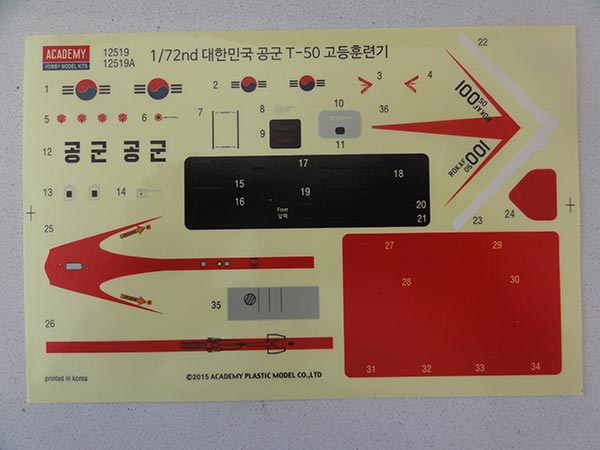
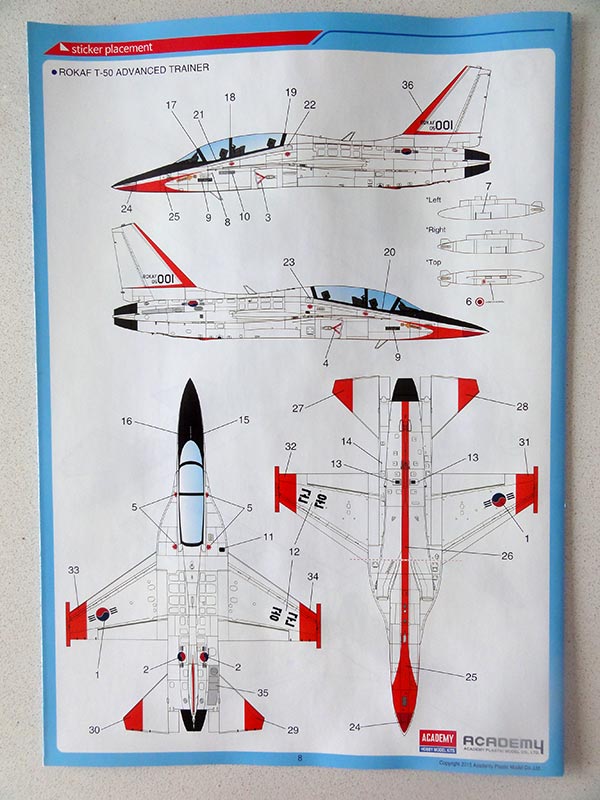
Also you do not get a landing gear but a transparant display stand.
But the surface detailing is nicely done though you only get a central fuel tank. The kit snaps together indeed with almost no gaps.
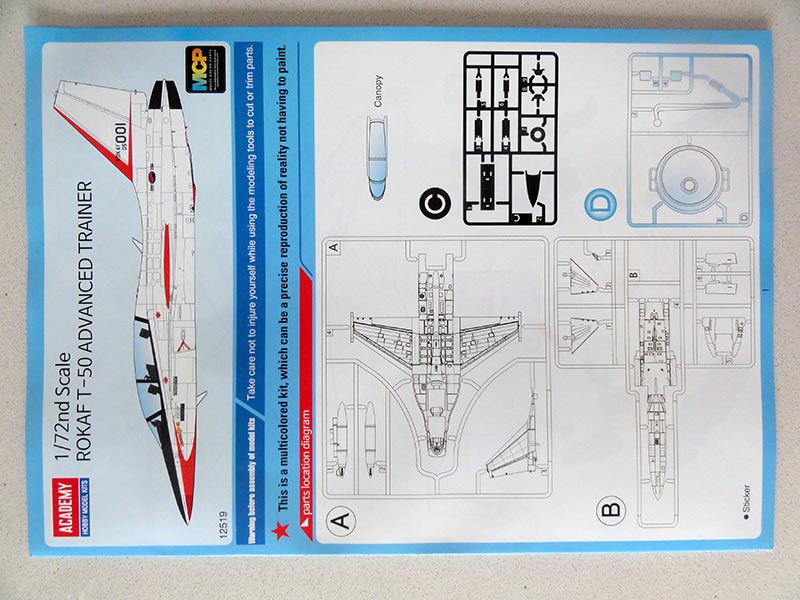
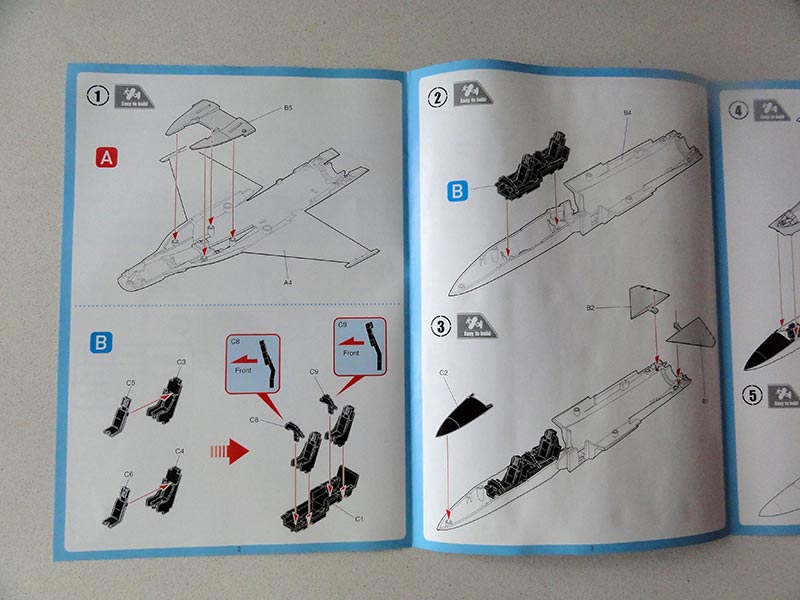
MODIFICATIONS
The model parts are for the early prototype trainer and in order to capture the production T-50 trainers (T) and Fighter Attack (FA) some modifications are needed:
[1] the vertical tail tip is different; it was cut off and extended with a flat antenna fairing;
[2] at the vertical tail, 2 thin plates were set at the fin sides;
[3] aircraft can be fitted with a gun and than a small fairing and gun nozzle is seen on the left side LERX above the intake;
[4] some aircraft show small ECM? knobs at amidst the wing leading edge, these are located some 46 mm in 1/72 from the center line;
[5] the wing tips of the kit are fairings. For missile rails these are 5 mm too short at the front so extend these;
[6] detail in the cockpit as desired though the kit parts are a good basis for adding a bit more detail such as on the ejection seats;
[-] add pylons and stores if desired or keep the model in "clean" configuration; the inboard pylons are some 32mm from the centerline and the outboard some 47mm from the centerline.
[- ] add landing gear if desired (see notes below).
NOTE: Some reports suggest that the FA-50 light attack variant has a longer radar nose but I could not really see this; the Academy model nose a good shape and correct overall length of 182 mm.
It was decided to make a few kits for the "World Air Forces in Plastic series" and to do the modifications and add a landing gear from scrap on all the models.
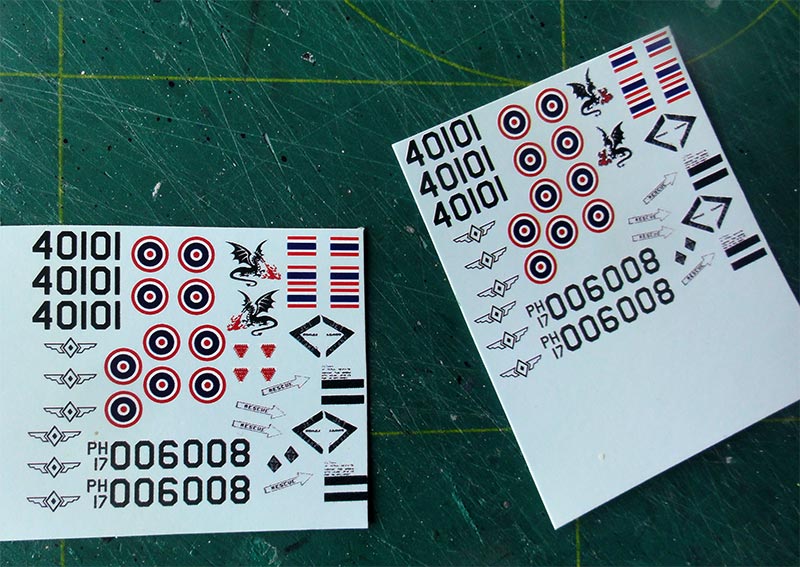
The needed decals had to be home designed looking at photos. A PC graphics program was used and the decals were than OKI laser printed by a Third Party. The decals are on a single clear film so each needed to be cut out with fine scissors. They do not need a decal film coverage as they are laser printed.
GENERAL NOTES
First the engraving of the flaps and ailerons was made a bit deeper with an Olfa P-cutter. The "static dischargers" attachment points at the trailing edges were shaved off and sanded flat. The cockpit tub is not bad with raised details and reasonable seat that look to be the ACES type.
The lower fuselage part #B4 was tackled to contain landing gear bays. I used the kit instructions of the Academy 1/48 scale T-50 kit for how the gear looks as seen here:

Note that the nose gear is quite different as the one of the F-16 and retracts forwards:
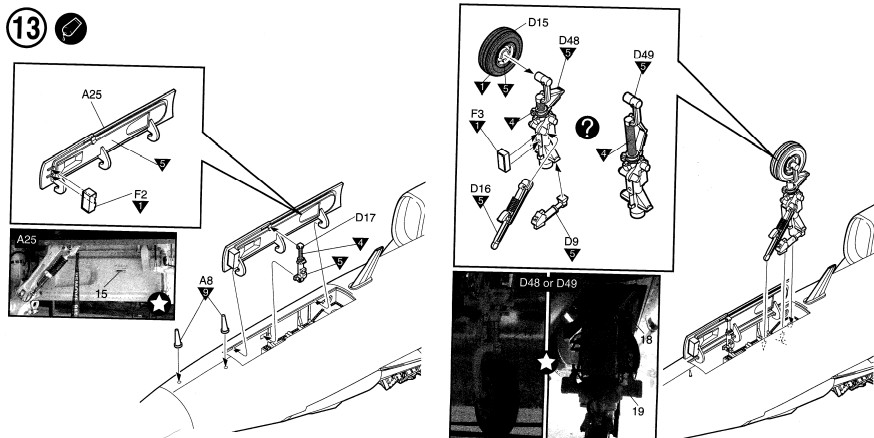
First, the bays were to be opened up. With a razor saw a cut was made at the intake location.

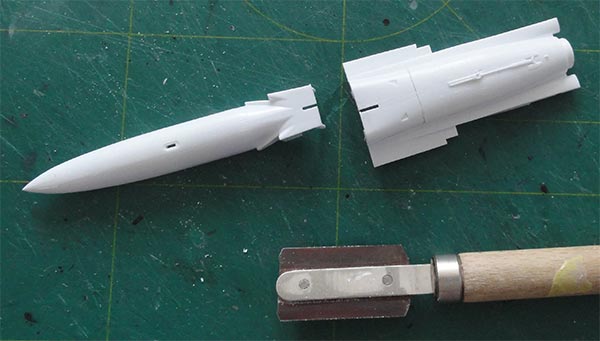
Than, the bay boundaries as engraved were scribed in with the razor saw. After a while, the central main gear door section became loose.
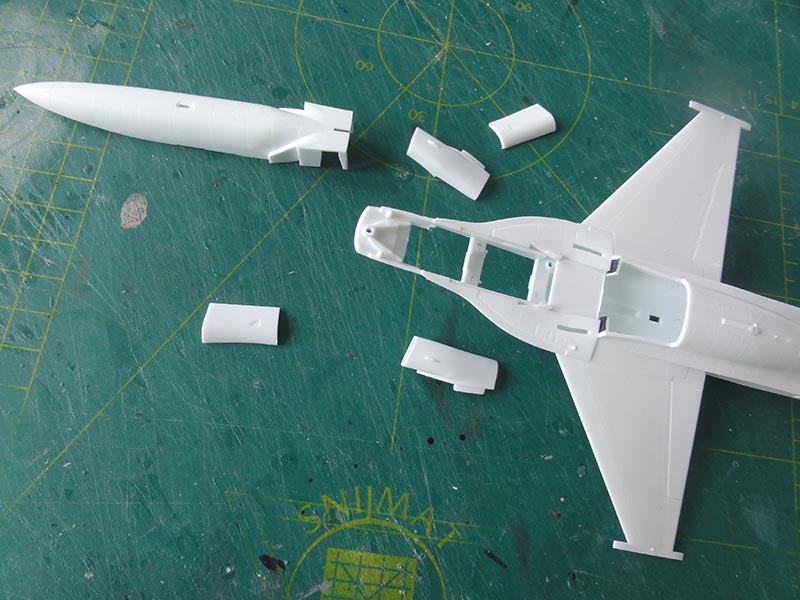

The central beam was made from strip and the gear bays with bended card. Same with the nose gear bay. It all did not take a lot of effort.

The remainder of the model was now assembled. At the rear airbrakes there is some plastic shrinkage so full with putty and sand. During assembly with glue, I removed all bigger click pins. Before closing the fuselage, added some nose weight just in case.
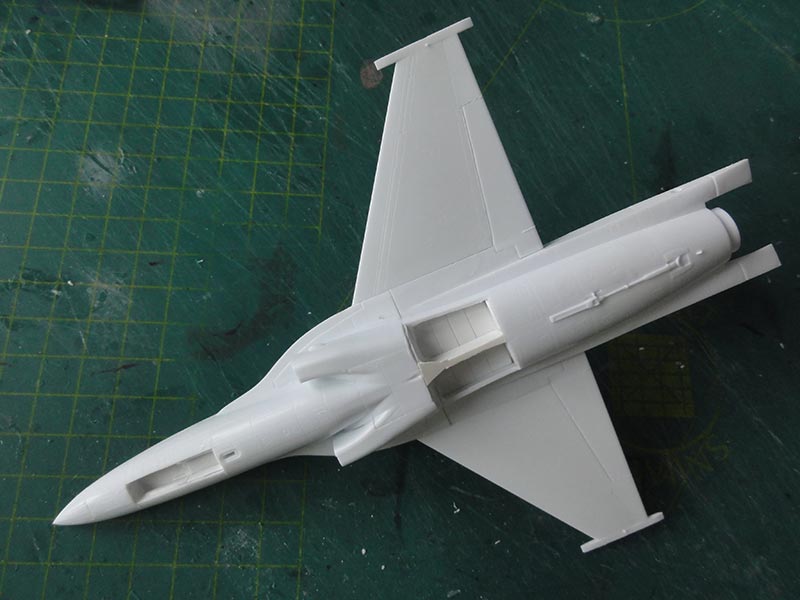
After main assembly was done, just some putty and sanding was needed at the lower fuselage at the intakes. A base grey coat was airbrushed with Revell Aqua 75 steingrau acrylic and any imperfections repaired with putty and sanding. Any grey can be used though.
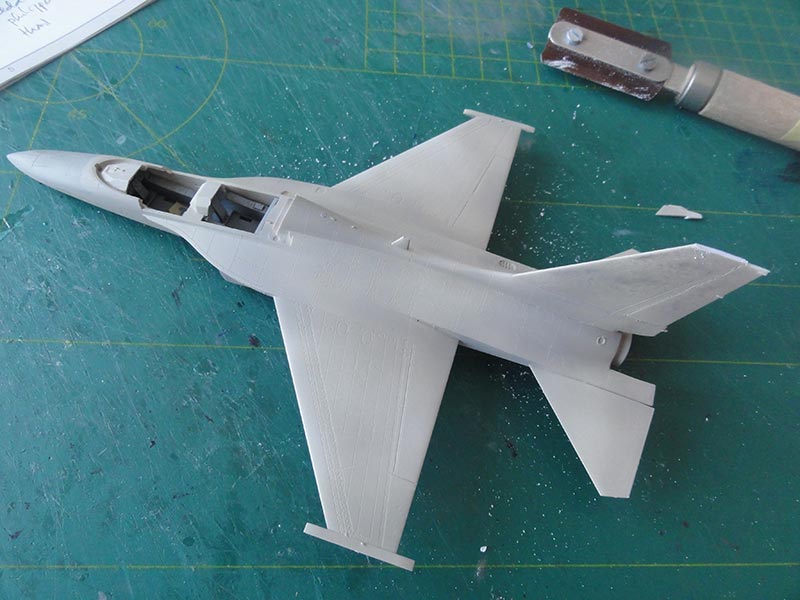
The vertical tail tip [see 1 above] was cut off and extended with thick rod for the antenna fairing sanded in shape. Two thin plates were added on the side [see 2].
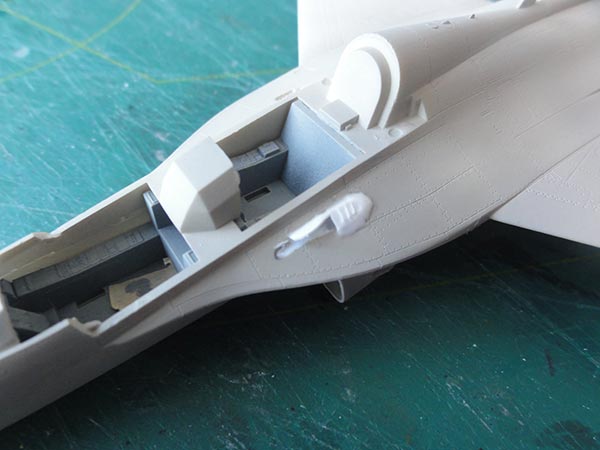
The gun nozzle slot at the LERX can be crafted, drilled open and a small gun fairing and plate made from card [see 3]. NOTE that some pure T-50 trainers do not have the gun fitting, so study photos.
The 2 small ECM? knobs [see 4] on the wing leading edge were made from plastic rod.
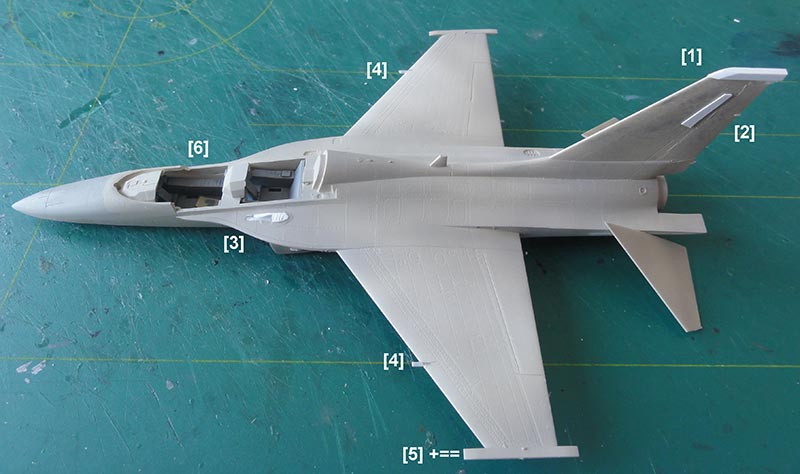
The gear looks like an F-16 gear (which KAI also produced in license in South Korea). I had a spare 1/72 scale F-16 main gear from a Revell F-16. The gear was used as pattern to make the legs from scrap with rod and metal wire.

Spares box...
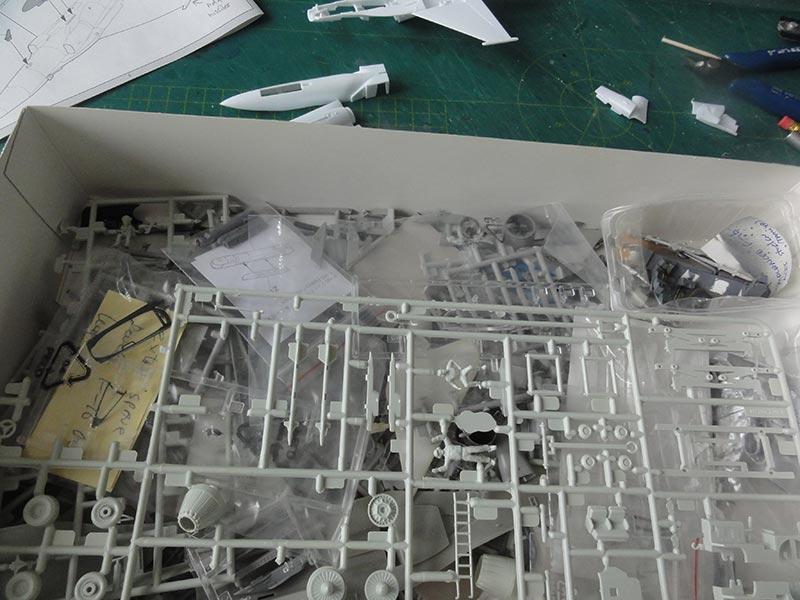

Wheels used on the T-50 model are spare F-16 wheels of the thin type F-16A/B wheel type; these will be installed later on. The separated main doors were recovered after they had been sanded thinner. The nose door was made from a piece of card.
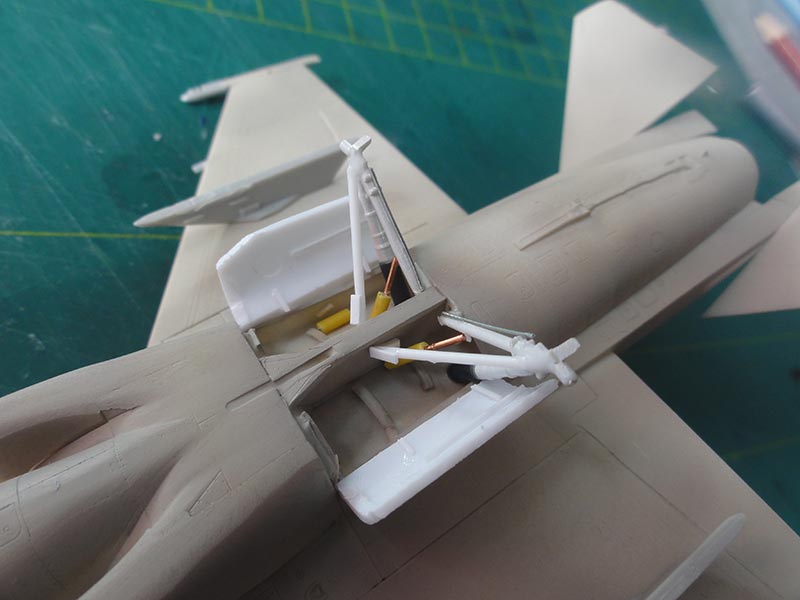
A few door retraction rods are still to be added.
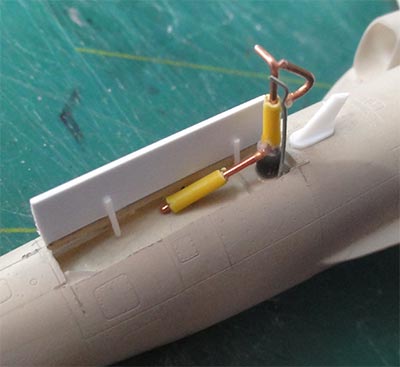
Landing gear and bay interiors are mainly gloss white inside. The cockpit interior is mainly FS36231 grey for which Gunze Sangyo H317 can be used with black ejection seats.
The kit ejection seats can be used but better detailed a bit with harnesses etc. Also close the rear opening with card. These look like ACES F-16 type seats.
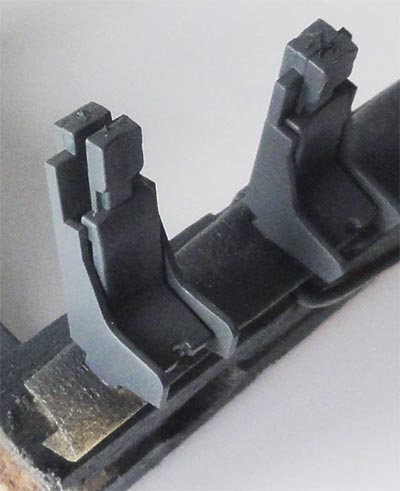
As noted, a few Academy models will be made, all with added landing gear.
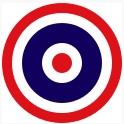
The first T-50 model was made as a T-50TH of Thailand. Studying a lot of photos was done but the internet has plenty of these. Some Thai aircraft appear to have FA-50 capability with the gun fitted but I also saw photos without gun nozzle/ fairing. Some 12 were delivered starting April 2018 and a few additional aircraft were ordered later on. They have the codes 40101- 40114/ serials KhF2- ....
The model was assembled as described above with also the modifications [1]...[6] and landing gear.
The wing tip missile rails are 5 mm too short on the kit. Front bits from F-16 spares rails were used here to extend these.
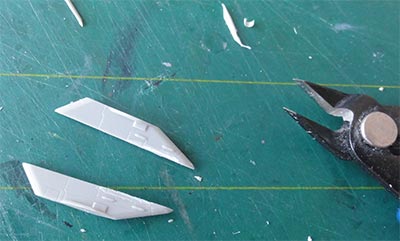
Two pylons were fitted that were were found in the F-16 spares box but were sanded flat (without bomb braces). The pylons are fitted on the inboard stations, some 32 mm from the center line.
The Thai T-50 model colours were difficult to establish and I could not find real information. Info from Nanond from IPMS Thailand suggested that the Thai Air Force does not use a clear standard and that squadrons often airspray local paints during the operational useage and variations in patterns.
My estimate is that a good choice is an overal Fed.Std FS36320 with a FS36118 pattern on the upper surfaces. Airbrushed were the Gunze Sangyo Mr Hobby acrylics H307 and H305 freehand and with a paper mask.
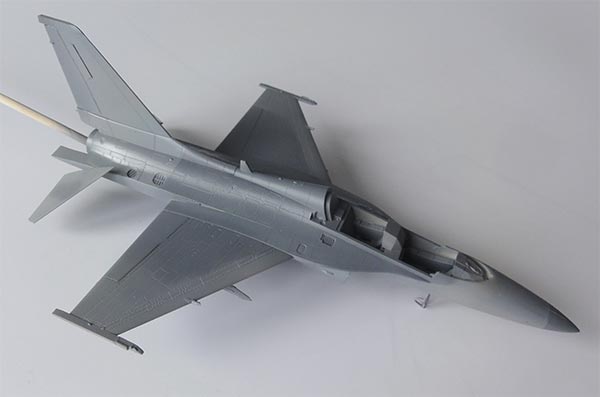
The home designed decals were used and applied after a gloss varnish coat had been airbrushed.

The landing gear and bays were brush painted gloss white. Wheel tyres were painted a mix of dark grey and black with white hubs.
Cockpit interior was painted mainly FS36231 grey for which Gunze Sangyo H317 can be used with black ejection seats. Seat harnesses were added made from fine tape. I used my own home printed decals with various instrument panels and side consoles that I had printed in the past for various purposes in various scales.
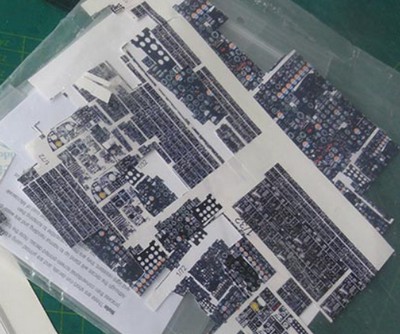
The canopy was set closed and the small gaps filled with white glue and painted when dried.
A Sidewinder missile was found in the spares box and set on the extended wing tip rail. The anti-collision lights were painted red and dark blue. On the fin top a clear light was added from a transparant bit.
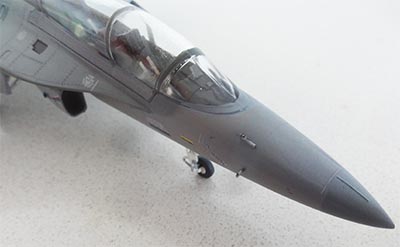
Small temperature probes and a pitot were made and added on the nose. To the rear trailing edges many static dischargers were added made from thin fishing wire. A final semi-gloss varnish coat was airbrushed while shielding off the canopy with my usual technique. That completed a special model.
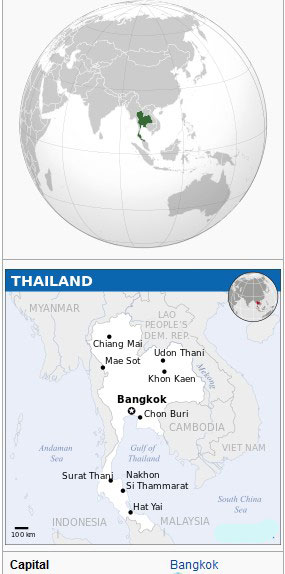


[ 513,000 sq.km | capital: Bangkok | 69 million inhabitants | GDP per capita $7,600 ]
For more information about the Thai air force look at my Fantrainer page here...
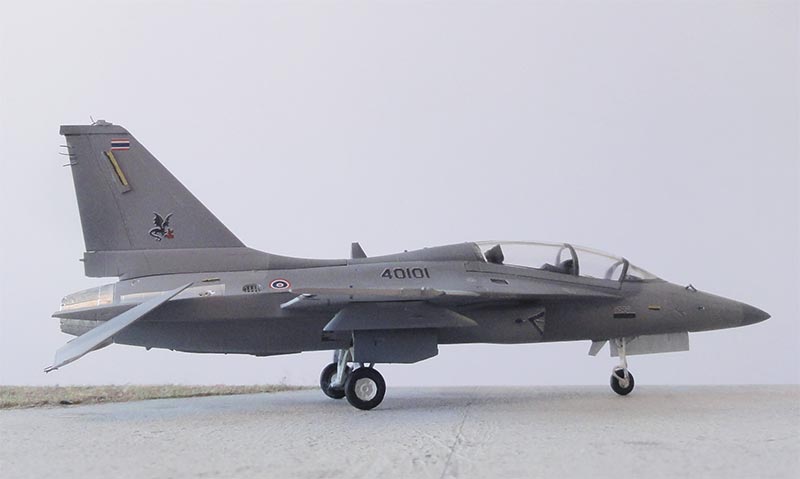
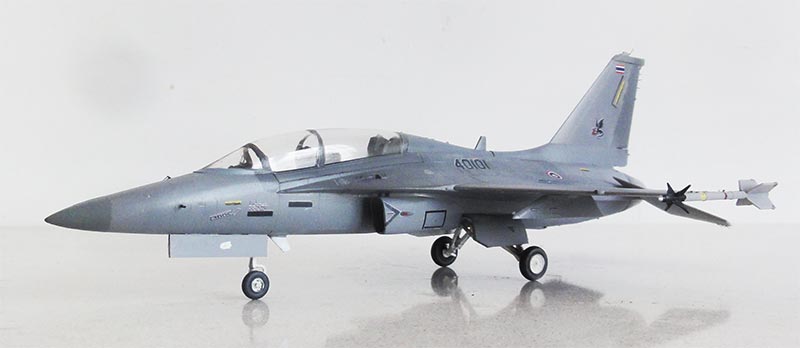
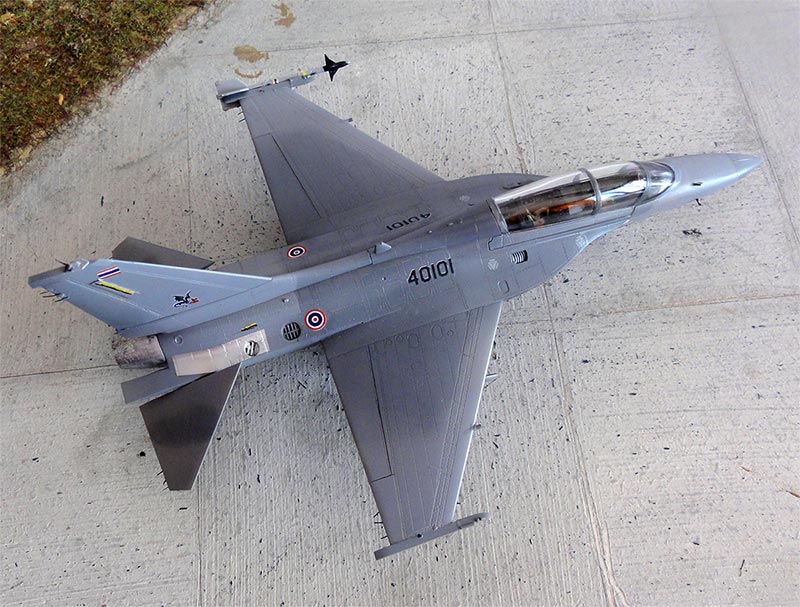
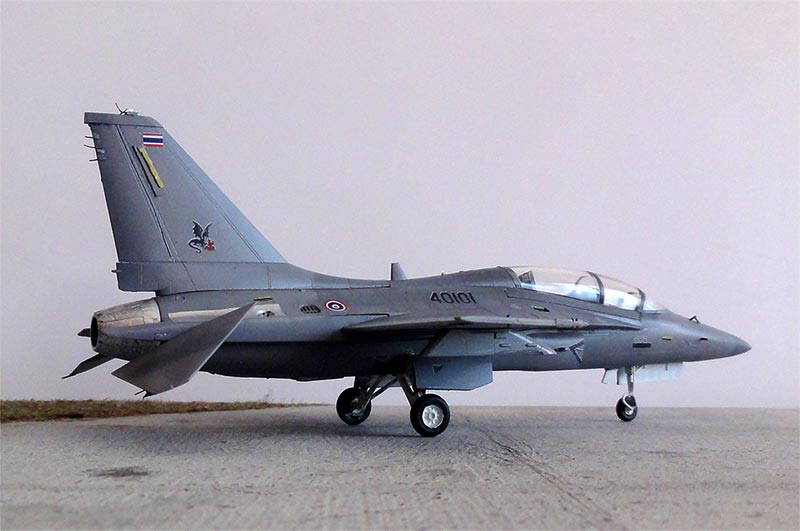
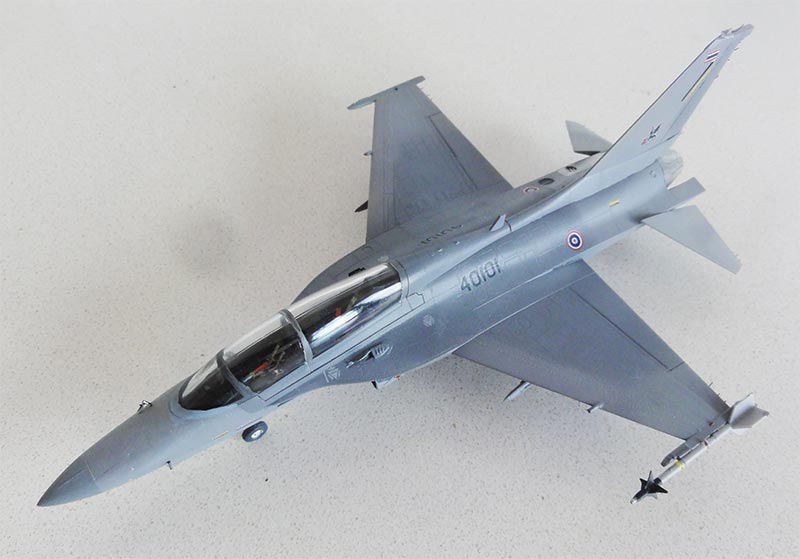
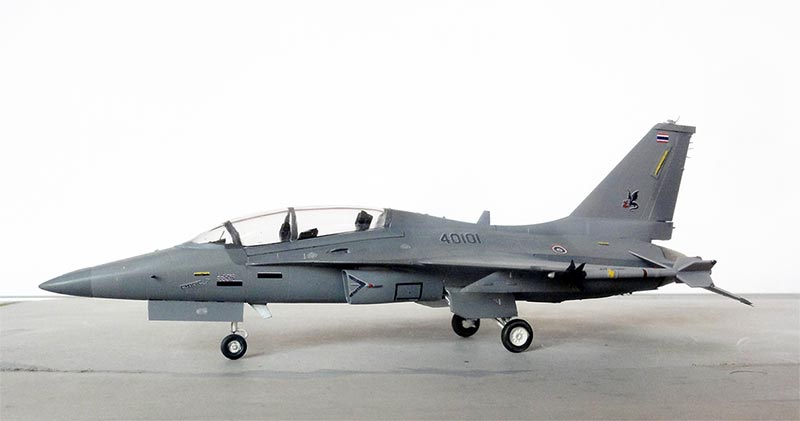
... at Korat base
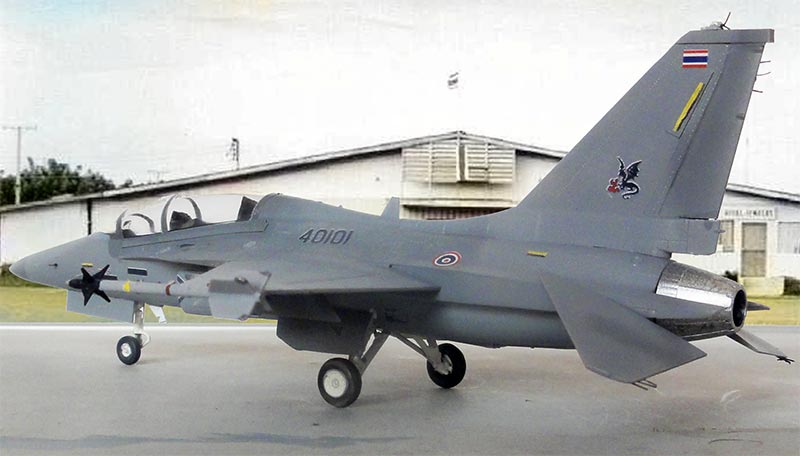
On to next [ Page 2... ]
References:
- Golden Eagle, Air international, February 2002, Volume 62 no 2, pages 95...
- T-50, Air Forces Monthly, #423, June 2023
Internet:
- WIKI T-50 page
Back to 1/72 Models

(c) Copyright Meindert "designer"/ All rights reserved. Your comments are welcomed by webmaster
Created this page August 24, 2022